Ficus microcarp: description, reproduction and care
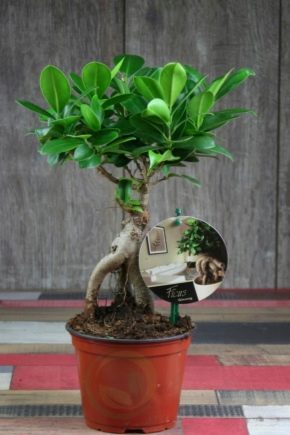
Ficuses are fairly common indoor plants that are loved all over the world. This green pet has an interesting look, while it is quite unpretentious in content, so interest in ficuses only increases every year. One of the most exotic varieties of this plant is the microcarp ficus.
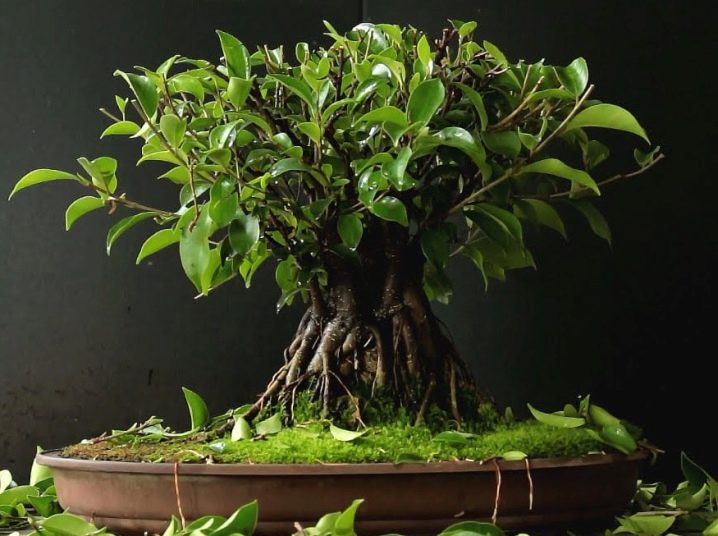
Description
Ficus microcarpa borrowed its name from the Greek language, mikros karpos translated into Russian means "little fruit". Another name for the plant - "Ginseng", which translates as "ginseng" - it means that the plant is not only beautiful, but also very useful. This type of ficus is characterized by the fact that at the bottom of its trunk there is a pronounced thickening formed from aerial roots, which over time can take on the most intricate forms. Under natural conditions, ficus microcarp grows in certain regions of China, and it can also be found in Indonesia and Taiwan, there are cases when the plant was also found in Australia.
Due to its unusual shape, ficus microcarp is referred to as epiphytes. In a natural environment, it grows up to 20-25 m, but in a domestic environment its length does not exceed 1.5 m. The length of the leaves of an adult mini-tree is 10 cm, and the width is 4-5 cm, the shape is pointed, the surface is rather smooth, glossy and shiny. The arrangement of leaves is alternate, cuttings are shortened. As the ficus matures, the upper part of its root system begins to rise above the ground and forms a variety of ornate bends and weaves - in this form, it looks very decorative, therefore ficus microcarpa is most often cultivated as bonsai, however, it is also sold in retail outlets in this form.
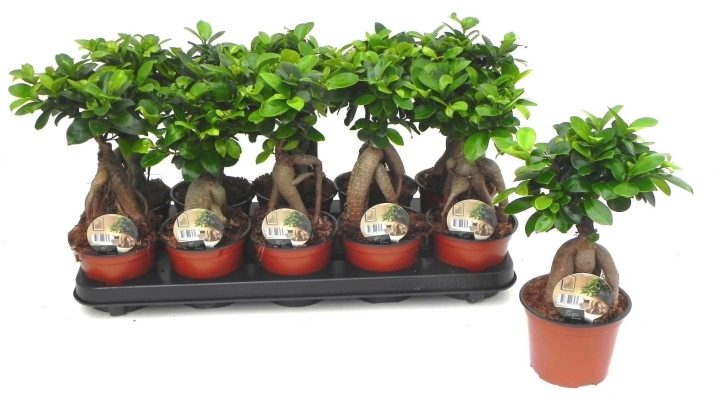
It is believed that microcarp ficus leaves purify the air and absorb all harmful substances. At the same time, there is an opinion that this pet is able to improve the energy of the house, maintains comfort and stability in family life.
But it is important to keep in mind that when the shoots are cut, juice is released, which quite often causes an allergic reaction. That is why all work on caring for a flower must be carried out with protective gloves.
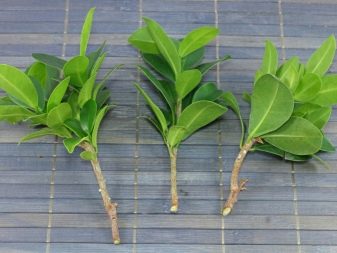
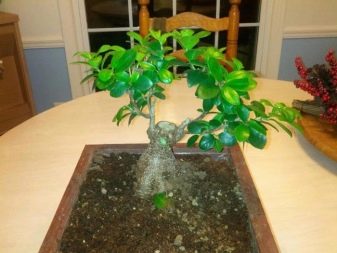
How to choose?
The most popular varieties of ficus microcarp include the following:
- "Green Graham" - these plants have a dense leafy crown;
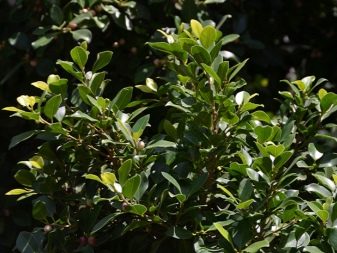

- Westland - characterized by elongated leaves, they grow up to 11–12 cm, while the width does not exceed 4–5 cm;
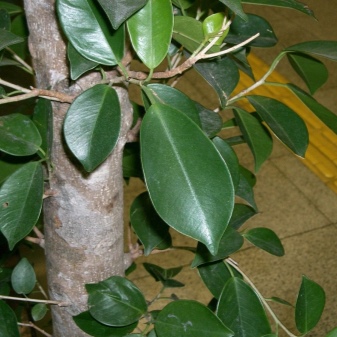
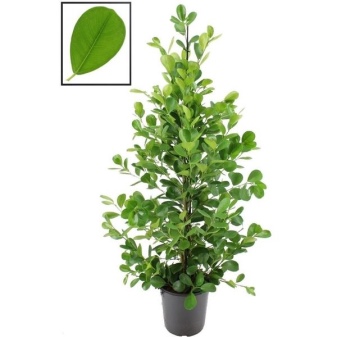
- "Moklame" - This is a beautiful plant with small rounded dark green leaves;
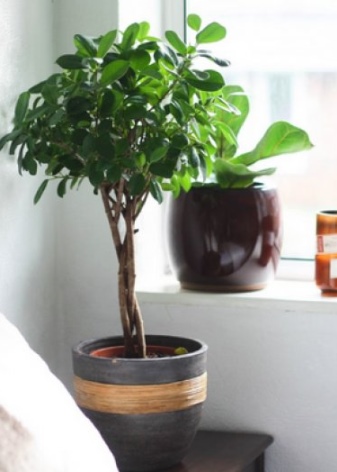
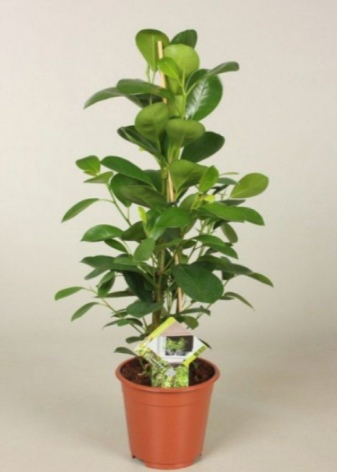
- "Variegata" - This is one of the most unusual ficuses, its leaves are variegated.

Choosing the most unusual type of ficus for yourself is just one of the tasks. It is equally important to choose the right pots and soil mixture for your pet, as well as provide the young tree with the conditions necessary for successful adaptation. The main requirement for a container for ficus is the arrangement of drainage holes. Ficuses prefer clay pots, preferably not covered with glaze - in this case, the porous surface will allow excess moisture to evaporate through the walls of the pot, in addition, it does not interfere with the flow of oxygen to the roots.The size of the pot must correspond to the plant - when transplanting, the distance between the walls of the container and the roots should be 2-3 cm. Keep in mind that any bonsai requires low and flat pots, standard containers are categorically contraindicated for such ficuses, since the soil that is not occupied by roots starts quickly sour, leading to decay of the entire root system and the death of the flower as a whole.
As for the substrate, it is advisable to purchase a specialized soil designed specifically for ficuses. But you can prepare a suitable soil mixture yourself. For this, leaf soil is disinfected by calcining or potassium permanganate and mixed with turf and sand in equal proportions, and then 0.3–0.5 parts of ash are added in order to lower the acidity level. Drainage is first laid in the pot (preferably from pebbles or expanded clay). Then a layer of earth is laid, the plant is installed and sprinkled with soil mixture so that all the voids are covered.


In new conditions, the ficus is experiencing quite a lot of stress, so you should know the following aspects of caring for a new flower:
- ficus "Ginseng" extremely negatively transfers movement, therefore, it must be immediately put in a permanent habitat and in the future it should not be moved anywhere;
- the plant does not like wind and strong drafts;
- ficus reacts poorly to direct ultraviolet rays and excessively dry air - try to choose a site for it so as to provide acceptable living conditions; a flower pot should be located away from batteries and other heat sources in the house, it is optimal to place it on the windows on the west, north-west or north side, if the plant you have chosen is variegated, then it will need more light - it makes sense to put such a ficus on the southern or southeastern windows;
- in the first days after buying a plant, it is important to ensure the optimal level of humidity in the chosen place - for this, the pot must be placed in a small pallet with moistened pebbles;
- you should spray the leaves from a spray bottle every day and, if possible, turn on a humidifier or at least a room fountain for 2-3 hours a day.
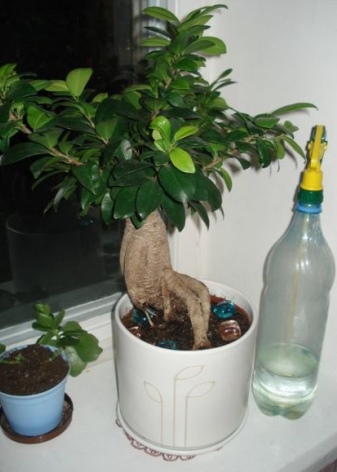

Important! As a rule, it takes 2-3 weeks for the plant to adapt, only after that it can be transplanted into a new pot.
How to care?
With properly organized care of microcarp ficus, even an inexperienced florist can quickly achieve the desired result - that is, get a mini-tree with a beautifully designed and lush crown. The most important factors in plant care are the following:
- correctly selected place of illumination;
- creation of an optimal temperature regime;
- timely pruning for the purpose of forming the crown and trunk.
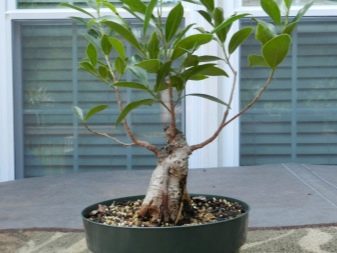

Top dressing
One of the main conditions for creating optimal microcarp for the growth and development of ficus is regular feeding. The plant requires fertilization from spring to fall. It is advisable to use a universal ready-made fertilizer intended for deciduous plants. Fertilizing is carried out 1 time in 2 weeks, and in winter, during the dormant period - only 1 time per month. Foliar dressing is very necessary, therefore, the plant needs spraying with nutrient solutions every 10-14 days - preparations for the ego can be taken the same, but their concentration should be reduced by 3-5 times.
Important! The nutrient should be applied only to moistened soil, otherwise you can get a burn of the roots.
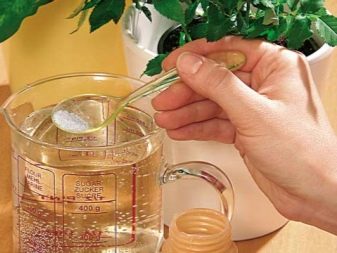
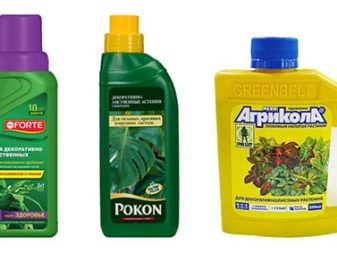
Watering
Bonsai are grown in a shallow, but at the same time wide, capacity, so the irrigation scheme here differs from that adopted for all other types of ficuses. A large area of land contributes to the accelerated evaporation of moisture, at the same time, with excessive moisture, the water simply has nowhere to go, since the volume of soil in such a pot is rather small. That is why the tree should be watered often, but little by little.Before each watering, be sure to check the soil - it should be dry 2-3 centimeters deep. Any excess water that accumulates in the sump after watering should be drained.
Ficus microcarp is very sensitive to the irrigation composition, therefore, water must be defended for several days before irrigation, and if possible, use thawed or rainwater - it has a more gentle structure. The water temperature must be at room temperature, otherwise the plant will simply shed all its leaves. Ficus microcarp loves high humidity, so it needs to be sprayed daily, and it is better to do it several times a day.
If you neglect this procedure, then the ficus quickly becomes lethargic and lifeless. If possible, try to clean the leaves as often as possible with a damp sponge or soft cloth.
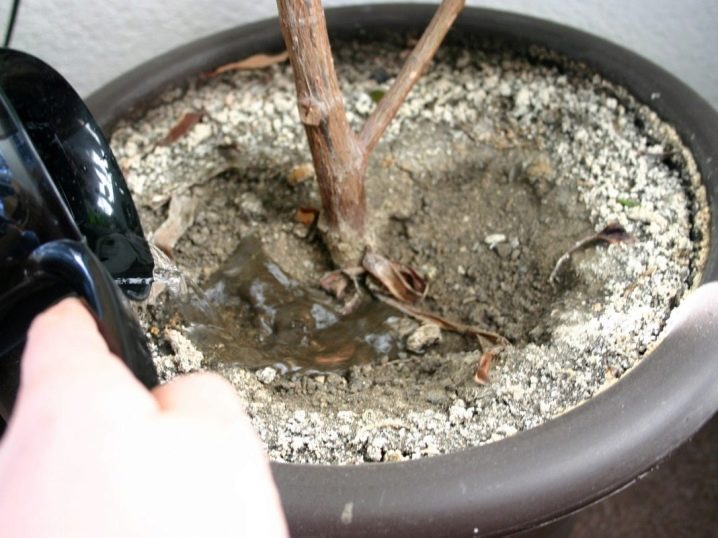
Fight disease
If the plant sheds leaves or they are yellow, white bloom and spots appear on them - the reason may be the action of pests, fungi and pathogenic microorganisms. Often, pests move to ficus from neighboring flowers, especially if they are crowded, and the air in the room is too warm and dry. In most cases, bonsai is attacked by spider mites and aphids. They make themselves felt with a thin cobweb near the base of the branches or the appearance of small black dots on the leaf plate. If you look closely, you can see the pests themselves on the back of the leaves. In this case, you should take up their elimination as soon as possible, since they are able to destroy the bonsai in the shortest possible time.
First, you need to make a solution of laundry soap and rinse the leaves and green parts of the stems with a solution of laundry soap with it, and then rinse the leaves under the shower to wash off all pests. Some of them may remain in the ground, so at the second stage it is imperative to transplant the flower into a new pot with a new substrate, be sure to first disinfect the soil mixture.
If the measures taken are not enough and after a while you notice new insects - you should resort to spraying with insecticides, they act quite effectively and at the same time very quickly.
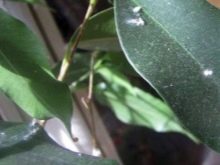
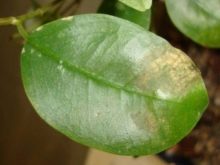
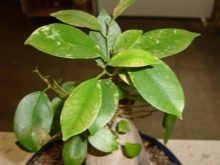
With excessive watering, spots of light and dark shades often appear on the aerial roots - they indicate the onset of fungal diseases and rot. In such a situation, all damaged areas should be carefully cut out and the entire plant should be treated with fungicidal solutions. If unexpectedly green leaves begin to fall off, it is most likely that the plant is often exposed to a draft or the ambient temperature is too low for it. In this situation, it is possible to weaken the immunity of the ficus and the development of all kinds of bacterial infections.
To avoid this, it is necessary to change the conditions of the flower's stay - in comfortable conditions, the leaves grow back rather quickly.
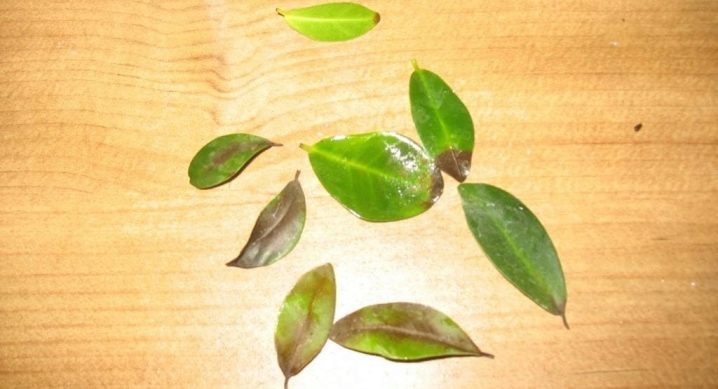
Pruning
Like any other bonsai, microcarp ficus requires frequent crown molding. When performing pruning, you should adhere to the following recommendations:
- to form active growth of lateral shoots and achieve maximum splendor of the bush, the apical bud should be removed;
- pruning is best done in spring - in this case, the crown will be more leafy.
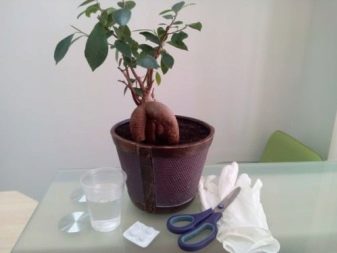
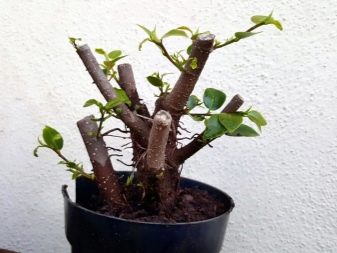
Usually the main shoot is cut at a height of 10-15 cm, thus stimulating the growth of axillary shoots - they also need to be pinched at a distance of 10 cm from the top. In order for all shoots to grow evenly, after molding, the plant should be periodically turned over in different directions to the sun. Any pruning solves immediately such problems as:
- rejuvenates the plant;
- allows you to give the ficus the desired shape;
- stimulates branching in the right place;
- changes the direction of growth of shoots.
If necessary, sanitary pruning of branches is carried out - removal of diseased and dried fragments.This can be done at any time of the year, regardless of the life cycle of the plant. And you should also prune the plant 2-3 weeks before transplanting. Keep in mind that plants that are weak and painful are not molded.
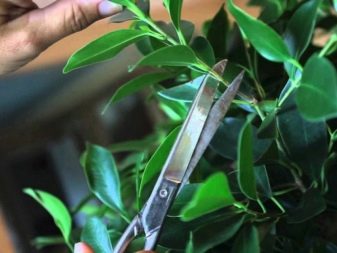
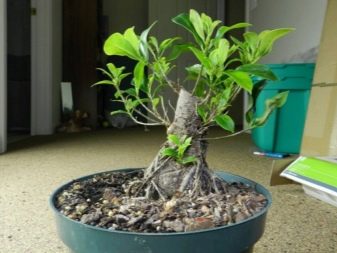
How to reproduce?
Ficus microcarp is propagated in several ways:
- Cuttings. To form a cutting, a semi-lignified apical shoot is cut from a tree, soaked in ordinary water for 24 hours to remove all the milky juice, and then placed in a container with water. For the prevention of decay, ash or crushed coal is poured there. As soon as the formed roots become noticeable, you need to transfer the fathoms to light soil to accelerate root formation. In order for it to take root better, the container is covered with a glass jar, and as soon as young leaves appear, it is removed and the stalk is transplanted to a permanent place.
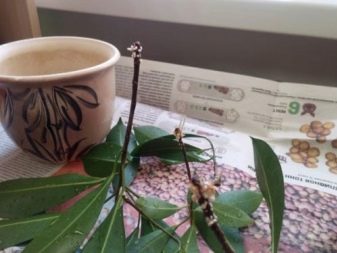
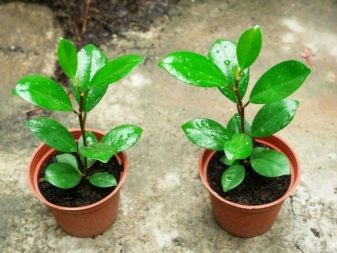
- Shoots. If you plan to grow your ficus from a shoot, you need to step back from the top of about 50 cm on an adult plant and cut off a piece of bark about 10 cm long. Bare wood is wrapped with moistened sphagnum and covered with polyethylene. After 30–45 days, roots are formed in this place - immediately after that, the crown, along with these young roots, is cut off and transplanted into a container for further rooting.
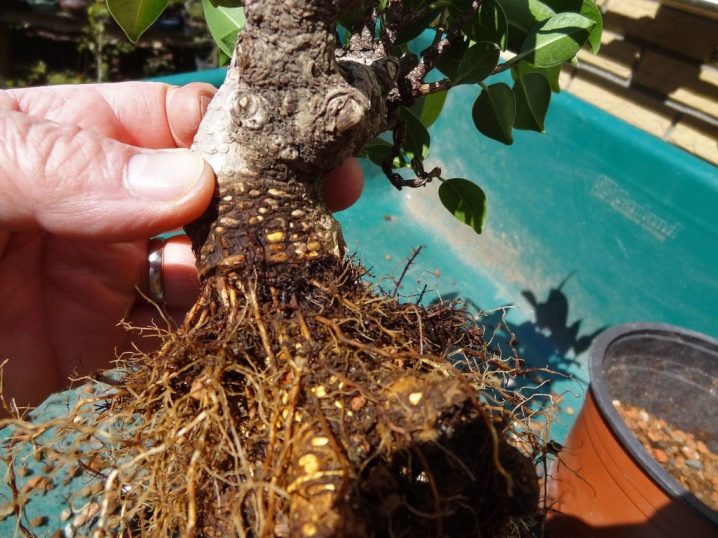
- Seeds. Growing bonsai from seeds is a long-term, but extremely effective way of propagation. Traditionally, planting is carried out in the spring, while the quality of the seed and the conditions for its storage are of great importance. If they did not meet the standard, then all the seeds lose their quality, germination remains practically zero. Drainage is poured at the bottom of the planting container, soil is brought in and seeds are spread, then sprinkled with river sand, covered with polyethylene or a glass lid and left in a warm place with diffused sunlight. As a rule, new plants begin to hatch after 3-4 weeks.
As soon as the first real leaves appear, it is necessary to make a pick, and after another 2-3 months, plant the future trees in different pots.
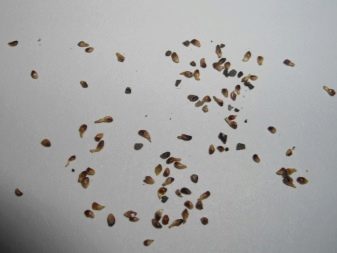
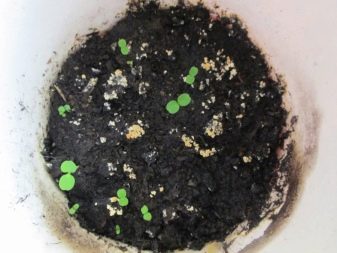
For breeding ficus at home, see the next video.































The comment was sent successfully.